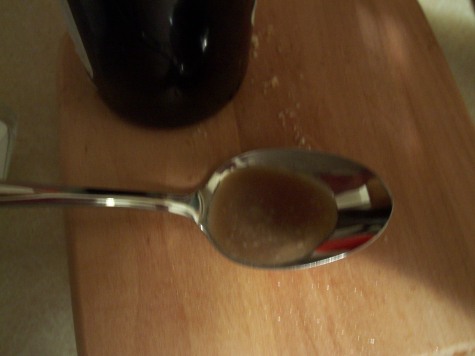My girlfriend Cat and I recently celebrated our first Valentines’ Day. Sadly, we did it apart since she’s currently living about two hours away from me in Harrisburg. When she came up this past weekend, I decided to do something special in order to make up for it: cook a miniature 18th Century meal for her.
To do this, I needed to get stocked up on seasonings and basics, most importantly the ubiquitous beef stock and mushroom catchup for gravy creation. Mushroom catchup, you ask? Prepare yourself, unsuspecting blog reader, for a whirlwind tour of condiment history.
Tomato catchup, as we 21st Century folks know it, did not exist at all in the 18th Century. At that time, the tomato was the innocent victim of two vicious urban legends: firstly, that it was poisonous (this may have been the result of acidic tomatoes interacting with poorly cleaned copper and cast-iron cookware), and secondly that it was an aphrodisiac (that’s why it’s still occasionally called the “Love Apple”). These myths weren’t dispelled until very late in the period.
In the meantime, the catchup people were using was more closely connected to its roots as the East Asian fish sauce ke-tsiap, which was brought back to Britain by merchants competing in the Spice Trade. There was both a light, vinegar based variety and a darker mushroom variety, both of which were used to flavor gravies and made dishes, and in a pinch combined with hot water to form a sort of thin sauce of their own. I was able to get a bottle of the light sauce from Deborah’s Pantry, but had to make the dark stuff myself. Fortunately, recipes abound. The one I prefer is from Lobscouse and Spotted Dog, and it’s a more modest scale reworking of one of Hannah Glasse’s 1747 recipes:
To make Catchup to keep twenty years: Take a gallon of strong stale beer, one pound of anchovies washed from the pickle, a pound of shalots peeled, half an ounce of mace, half an ounce of cloves, a quarter of an ounce of whole pepper, three or four large races of ginger, two quarts of large mushroom-flaps rubbed to pieces; cover all this close and let it simmer until it is half wasted, then strain it through a flannel bag; let it stand until quite cold and then bottle it. You may carry it to the Indies. A spoonful of this to a pound of fresh butter melted makes a fine fish-sauce, or in the room of gravy sauce. The stronger and staler the beer is, the better the catchup will be.
For this recipe I had access to my reenacting buddy Dave Woolsey’s home brewed 18th Century porter, so my beer base was very strong indeed. Don’t worry…Cat and I still had a bottle each for dinner.
Once scaled down to more reasonable amounts (the original recipe is directed at ship captains and so of course makes a tremendous lot of catchup), all of these ingredients boiled together make a flavorful, spicy, and slightly fishy sauce somewhat reminiscent of the Worcestershire sauce that would usurp its place in the 19th Century. They’re so reminiscent, in fact, that you could easily make some of this sauce without ever attempting to do anything “period”, just to use it with steak or meatloaf, or whatever else you’d normally use Worcestershire sauce for. You can also, in reverse, use Worcestershire where you’d use mushroom catchup in 18th century food, though it won’t have quite the same flavor.

Mushroom Catchup
-
1 pt strong stale beer
-
10 anchovies, or 1 can anchovy fillets, rinsed
-
4 shallots, peeled and coarsely chopped
-
5 oz. large flap mushrooms
-
1 two inch piece fresh ginger
-
1 tsp pepper
-
1/2 tsp mace
-
10 whole cloves
Put everything into a saucepan, bring to a boil, and simmer gently about 30 minutes. Strain and bottle.
I should note, for those of you of the vegan persuasion, that there is an all plant/fungus product version of this recipe in Maxime de la Falaise’s Seven Centuries of English Cooking. It’s based on a later recipe (1811) and has to sit in the fridge for a day or so, but it achieves much the same effect without anchovies.
Fish-Friendlier Mushroom Catchup
-
8 cups mushrooms
-
2-3 tbs salt
-
1 cup port
-
1/2 tsp allspice
-
1/4 tsp cloves
-
1/2 tsp mace
-
1/4 tsp pepper
Mash mushrooms, toss with salt, and leave in the fridge for about 2 days until juice is extracted, stirring occasionally. Strain juice and put in a saucepan, add all other ingredients, and bring to the boil. Simmer about 15 minutes. Bottle when cool.



